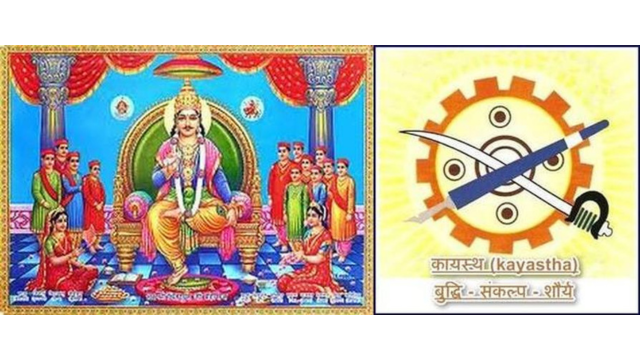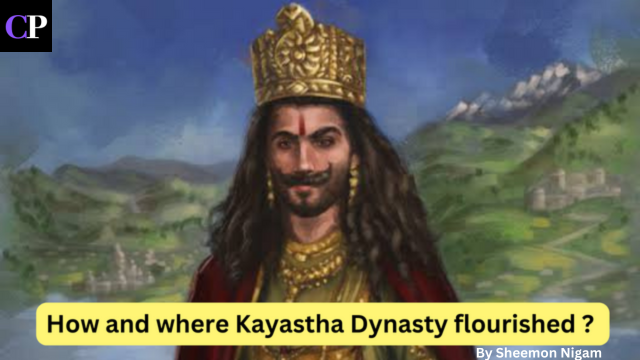Shri Chitraguptji Maharaj is considered to be the source of Kayasthas. Let us tell you about the origin of Kayastha dynasty.
How Chitraguptji was born ?
It is said that Brahma ji created four varnas – Brahmin, Kshatriya, Vaishya, and Shudra then Yama ji asked him for help in keeping the details of humans. Then Brahmaji got absorbed in meditation for 11000 years and when he opened his eyes he saw that “Ajanubhuj Karwal Pustak Kar Kalam Masibhajanam” i.e. he found a man in front of him with a pen, inkpot, book and a sword tied at his waist.
Brahma ji said, “O man, who are you?” Then the man said, “I was secretly residing in your mind, now you name me and entrust me with whatever responsibility you have.” Then Brahma ji said, “As you, Because you were hidden (merged) in my Chitra (body), you will be known by the name of Chitragupta. And your work will be to keep an account of the good deeds and bad deeds done by every living being while secretly residing in the body of each living being and to do justice accordingly and give gifts. And to arrange punishment. Since you will reside secretly in the body of every living being, hence you and your children will also be called Kayastha.
Shri Chitragupta ji has been addressed as a very powerful Kshatriya. He had two marriages.

His first wife Suryadakshina/Nandani who was a Brahmin girl, had 4 sons from him:
Bhanu (Srivastava)
His zodiac name was Dharmadhwaj who was sent by Chitragupta ji to establish the kingdom in the area of Srivas (Srinagar) and Kandahar. He was married to Padmini, daughter of Nagraj Vasuki. From that marriage, two divine sons named Devdutt and Ghanshyam were born. Devdutt got the kingdom of Kashmir and Ghanshyam got the kingdom on the banks of river Indus. Srivastava is divided in to two classes namely Khar and Dooser. Some of the Al are as follows: Verma, Sinha, Aghori, Pade, Pandiya, Raizada, Kanungo, Jagdhari, Pradhan, Bohar, Raza Surajpura, Tandwa, Vaidya, Barwaria, Chaudhary, Raza Sandila, Devgan etc.
Vibhanu (Suryadhvaja)
His zodiac name was Shyamsundar who was married to Devi Malati. Maharaja Chitragupta sent Vibhanu to establish his kingdom in the northern regions of Kashmir. Since his mother Dakshina was the daughter of Suryadev, his descendants put the symbol of Suryadev on their ensign and came to be known as Suryadhvaj. Ultimately he came and settled in Magadha.
Vishwabhanu (Valmik)
His zodiac name was Deendayal and he worshiped Goddess Shakambhari. Maharaj Chitragupta ji had sent him to establish the kingdom in the Valmiki region near Chitrakoot and Narmada. He was married to Nagakanya Devi Bimvvati. It is known that he spent a large part of his life doing penance on the banks of river Narmada. At the time of this penance, his entire body was covered with a creeper named Valmiki. His descendants were known as Valmiki and became Vallabhpanthis. His son Shri Chandrakant settled in Gujarat and other sons along with their families migrated to North India near Ganga and Himalayas. Today they are found in Gujarat and Maharashtra. In Gujarat, they are also called “Vallabhi Kayastha”.
Veeryabhanu (Asthana)
His zodiac name was Madhavrao and he married Goddess Singhadhwani. He used to worship Goddess Shakambhari. Maharaj Chitragupta ji sent Shri Veeryabhanu to establish the kingdom in Adhisthan. His descendants came to be known as Ashthana and the Maharaja of Ramnagar (Varanasi) ranked them among his eight gems. Today the Asthana live in many districts of Uttar Pradesh and Saran, Siwan, Champaran, Muzaffarpur, Sitamarhi, Darbhanga, and Bhagalpur areas of Bihar. Apart from this, their number in Madhya Pradesh is also worth keeping in mind. They are divided into 5 Al.
The second wife Iravati/Shobhavati was a Nagavanshi Kshatriya girl, from whom he had 8 sons:
Chitracharu (Nigam)
His zodiac name was Sumanta and he was married to Ashgandhamati. He used to worship Goddess Durga. Maharaj Chitragupta ji sent Shri Chitracharu Kayastha to establish the kingdom in the Mahakoshal and Nigam area (on the banks of river Saryu). His descendants were well-versed in the methods of Vedas and Shastras which gave them the name Nigam. Today they live in Kanpur, Fatehpur, Hamirpur, Banda, Jalaon, and Mahoba. They are divided into 43 Als, some of which are as follows: Kanungo, Akbarpur, Akbarabadi, Ghatampuri, Chaudhary, Kanungo Badha, Kanungo Jaipur, Munshi, etc.
Atindriya (Kulshreshtha)
His zodiac name is Sadanand and he is married to Goddess Manjubhashini. He worships Goddess Lakshmi. Maharaj Chitragupta ji had sent Shri Atindriya (Jitendriya) Kayastha to establish the kingdom in Kannauj region. Among the twelve children of Shri Atiendriya Chitragupta ji, he was among the children with more religious and ascetic tendencies. He was known as ‘Dharmatma’ and ‘Pandit’ and was virtuous by nature. In modern times they are found in Mathura, Agra, Farrukhabad, Itah, Etawah, and Mainpuri. Some Kulshreshtha who are from the lineage of Mata Nandini are found in Nandigaon (Bengal).
Charu (Mathur)
He was the disciple of Guru Mathur. His zodiac name was Dhurandhar and he was married to Goddess Pankajakshi and he worshiped Goddess Durga. Maharaj Chitragupta ji had sent Shri Charu to establish the kingdom in the Mathura region. His descendants were known as Mathur. He defeated the demons (who did not believe in the Vedas) and established a kingdom in Mathura. After this, he expanded his kingdom to other parts of Aryavarta also. Mathuras also held many positions in the courts of Suryavanshi kings who ruled Mathura like Ikshvaku, Raghu, Dasharatha, and Ram.
The Mathur is divided into 3 sections: Dehlavi, Khachauli, and Kachhi of Gujarat. They have 84 Als some of which are as follows: Kataria, Sahariya, Kakrania, Dwariya, Dilwariya, Tawakale, Rajouriya, Nag, Galgotiya, Sarwariya, Ranoriya etc. According to Madan Kosh written by Madanlal Tiwari of Etawah, the Mathuras established the Pandya kingdom which was spread in today’s areas like Madurai, and Trinivelli. The messengers of the Mathuras also went to the court of Augustus Caesar of Rome.
Chitra (Bhatnagar)
He was a disciple of Guru Bhat who was married to Goddess Bhadrakalini. He used to worship Goddess Jayanti. Maharaj Chitragupta ji had sent him to establish a kingdom on the banks of the Bhat River in Bhat country and Malwa. He established Chittor and Chitrakoot and settled there. Their descendants came to be known as Bhatnagar which is divided into 84 Als, some of which are as follows: Dasniya, Bhatniya, Kuchaniya, Gujriya, Bahliwal, Mahiwal, Sambhalveda, Barsania, Kanmaujia, etc. Bhatnagar is a common surname among Kayasthas in North India.
Matibhan (Saxena)
He was married to Goddess Koklesh and worshiped Goddess Shakambhari. Chitragupta ji sent Shri Matiman to establish a kingdom in the Shaka area. His son was a great warrior and established his kingdom over modern-day Kandahar and Eurasia landmasses. Since he was a Shaka and belonged to the Shaka Empire and was friendly with the Sena Empire, his descendants were called Shaksen or Saksen. A part of modern Iran was part of his kingdom. Today they are found in Kannauj, Pilibhit, Badaun, Farrukhabad, Etawah, Etawah, Mainpuri, and Aligarh. Saxena are divided into ‘Khare’ and ‘Doosar’ and there are 106 Al in this community. Some of the Al are as follows: Johari, Hajela, Adholiya, Raizada, Codesia, Kanungo, Barataria, Bisaria, Pradhan, Kamthania, Darbari, Rawat, Saharia, Dalela, Sonreksha, Kamojiya, Agochiya, Sinha, Moriya etc.
Sucharu (Gauda)
He was a disciple of Guru Vashishtha and his Rashi name was Dharmadatta. He used to worship Goddess Shakambari. Maharaj Chitragupta ji had sent Shri Sucharu to establish the kingdom in the Gaur region. Shri Sucharu was married to Devi Mandhiya, daughter of Nagraj Vasuki. Gaurs are divided into 5 classes: Khare, Dusse, Bengali, Dehlavi and Vadanauni. Gaud Kayastha is divided into 32 groups and among them Bhagadatta of Mahabharata and Rudradatta of Kalinga are famous.
Charun (Karna)
His zodiac name was Damodar and he was married to Goddess Kokalasuta. He worshiped Goddess Lakshmi and was a Vaishnav. Maharaj Chitragupta ji had sent Shri Charun to establish a kingdom in the Karna region (modern Karnataka). Their descendants migrated to the northern states over time and are today found in Nepal, Orissa, and Bihar. Their Bihar branch is divided into two parts: ‘Gayawal Karna’ (who settled in Gaya) and ‘Maithil Karna’ (who settled in Mithila). Among these, titles like Das, Dutt, Dev, Kanth, Nidhi, Mallik, Labh, Chaudhary, Rang, etc. are prevalent. A specialty of Maithil Karna Kayasthas is their Panji system. Panji is a system of genealogical records. Karna is divided into 360 divisions and the reason for this huge number is the Karna family who migrated from South India to the North in several stages. This Kayastha has no relation with the Karna of Mahabharata.
Himavan (Ambashta)
His zodiac name was Sarandhar and he was married to Goddess Bhujangakshi. He used to worship Goddess Amba Mata. Due to their settlement in the area called Amba-sthan of Girnar and Kathiwar, they were named Ambasht. Sri Himavan had five divine children: Nagasena (24 alases), Gayasena (35 alas), Gayadatta (85 alas), Ratanamul (25 alas) and Deodhar (21 alas). These five sons settled in different places and carried forward their lineage to these places. Ultimately he settled in Punjab where he was defeated by Alexander’s generals and then by Chandragupta Maurya.
Ambastha Kayastha follows the tradition of intercaste marriage and uses the “Khas Ghar” system for this. The names of these houses are also used as surnames. The names of some “khas ghars” (which reveal the names of those villages in the Magadha state where the Ambashtas settled after being displaced from Takshashila during the Maurya period) are: Bhilwar, Dumarve, Badhiyar, Bharthuar, Nimeiyar, Jamuar, Katrayar Parvatiyar, Mandilwar, Majorwar, Rukhiyar, Maldahiyar, Nandkuliyar, Gahilwar, Gayawar, Bariyar, Baratiyar, Rajgrihar, Dedghawe, Kochgawe, Chargawe, Viranwe, Sandawar, Panchbare, Sakaldihar, Karapatne, Panpatne, Harghawe, Mahatha, Jaipuriyar etc.
